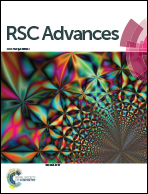Ghatti gum-base graft copolymer: a plausible platform for pH-controlled delivery of antidiabetic drugs
Abstract
In the present study, we aimed to develop a novel pH-sensitive polymeric delivery system (GG-g-PMMA) for antidiabetic therapy via grafting ghatti gum (GG) with methyl methacrylate (MMA) chains. The free radical polymerization technique was adopted to graft ghatti gum with methyl methacrylate, using ceric ammonium nitrate (CAN) as a redox initiator. The impact on grafting parameters such as grafting percentage (G%) and grafting efficiency (GE), of monomer and initiator concentrations was evaluated. The batch with higher grafting efficiency and percentage grafting was selected and characterized by elemental analysis (C, H and N), DSC, FT-IR spectroscopy, XRD, 1H-NMR and SEM morphology study. In addition, the efficacy of GG-g-PMMA-based pellets loaded with the hypoglycemic agent, metformin hydrochloride, to sustain drug release was investigated. In vitro release studies demonstrated a pH-dependent sustained release of the drug from GG-g-PMMA pellets. In addition, acute oral toxicity studies and histopathological analysis suggested the safety and biocompatibility of the grafted gum. Most importantly, in vivo efficacy studies underscored the efficient hypoglycemic potential of the prepared formulation, which was comparable to that of a sustained release marketed formulation. These results suggest that the developed pH-sensitive polymeric delivery system (GG-g-PMMA) might represent a promising delivery vehicle for facilitated antidiabetic therapy.



 Please wait while we load your content...
Please wait while we load your content...